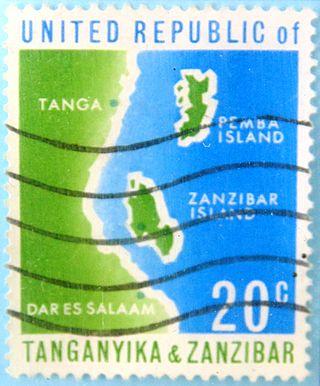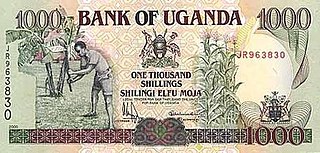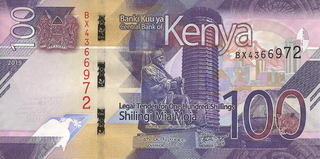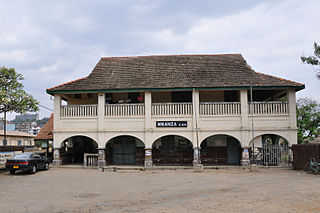
The shilling is a historical coin, and the name of a unit of modern currencies formerly used in the United Kingdom, Australia, New Zealand, other British Commonwealth countries and Ireland, where they were generally equivalent to 12 pence or one-twentieth of a pound before being phased out during the 1960s and 1970s.

East Africa, also known as Eastern Africa or the East of Africa, is a region at the eastern edge of the African continent, distinguished by its geographical, historical, and cultural landscape. Defined in varying scopes, the region is recognized in the United Nations Statistics Division scheme as encompassing 18 sovereign states and 4 territories.
Kenya, Uganda, Tanganyika (KUT) is the name on British postage stamps made for use in the British colonies of Kenya, Uganda, and Tanganyika. The stamps were circulated between 1935 and 1963 by the joint postal service of the three colonies, the East African Posts and Telecommunications Administration, reconstituted as part of the East African High Commission from 1948 to 1961, the East African Common Services Organization from 1961 to 1967, and the East African Community from 1967 to 1977. Even after independence, the new separate nations continued to use the KUT stamps, and they remained valid for postage until 1977.

The story of the postage stamps and postal history of Tanzania begins with German East Africa, which was occupied by British forces during World War I. After the war, the territory came under British rule, was named Tanganyika and issued stamps under that name until after a union with Zanzibar in 1964.
This is a survey of the postage stamps and postal history of Tanganyika under British mandate.

The shilling is the currency of Uganda. Officially divided into cents until 2013, due to substantial inflation the shilling now has no subdivision.

A currency union is an intergovernmental agreement that involves two or more states sharing the same currency. These states may not necessarily have any further integration.

The Bank of Uganda is the central bank of Uganda. Established in 1966, by Act of Parliament, the bank is wholly owned by the government but is not a government department.

The shilling is the currency of Kenya. It is divided into 100 cents. The Central Bank of Kenya Act cap 491, mandated the printing and minting of the Kenyan shilling currency.

The East African shilling was the sterling unit of account in British-controlled areas of East Africa from 1921 until 1969. It was issued by the East African Currency Board. It is also the proposed name for a common currency that the East African Community plans to introduce.

The Bank of Tanzania is the central bank of the United Republic of Tanzania. It is responsible for issuing the national currency, the Tanzanian shilling.
Each "article" in this category is a collection of entries about several stamp issuers, presented in alphabetical order. The entries are formulated on the micro model and so provide summary information about all known issuers.
Shilingi is the Swahili word for "shilling". Specifically it may refer to:

The Sultanate of Zanzibar, also known as the Zanzibar Sultanate, was an East African Muslim state controlled by the Sultan of Zanzibar, in place between 1856 and 1964. The Sultanate's territories varied over time, and after a period of decline, the state had sovereignty over only the Zanzibar Archipelago and a 16-kilometre-wide (10 mi) strip along the Kenyan coast, with the interior of Kenya constituting the British Kenya Colony and the coastal strip administered as a de facto part of that colony.

The Central Bank of Kenya (CBK) is the monetary authority of Kenya. Its head office is located in Nairobi. CBK was founded by in 1966 after the dissolution of East African Currency Board (EACB). Dr. Kamau Thugge, CBS is the current Governor and Dr. Susan Koech is the Deputy Governor.
The Indian diaspora in Southeast Africa consists of approximately 3 million people of Indian origin. Some of this diaspora in Southeast Africa arrived in the 19th century from British India as indentured labourers, many of them to work on the Kenya–Uganda railway. Others had arrived earlier by sea as traders.

The following outline is provided as an overview of and topical guide to Kenya:

The following outline is provided as an overview of and topical guide to Tanzania:

The history of rail transport in Tanzania began in the late nineteenth century.
















